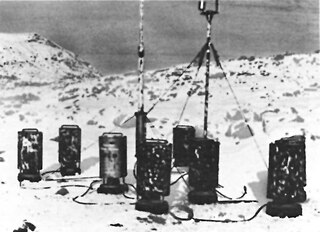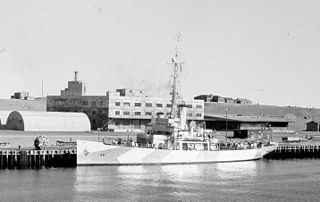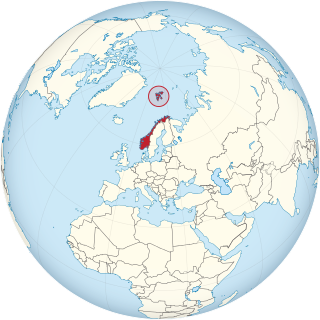
Jan Mayen is a Norwegian volcanic island in the Arctic Ocean with no permanent population. It is 55 km (34 mi) long (southwest-northeast) and 373 km2 (144 sq mi) in area, partly covered by glaciers. It has two parts: larger northeast Nord-Jan and smaller Sør-Jan, linked by a 2.5 km (1.6 mi) wide isthmus. It lies 600 km (370 mi) northeast of Iceland, 500 km (310 mi) east of central Greenland, and 900 km (560 mi) northwest of Vesterålen, Norway.

The Battle of the Atlantic, the longest continuous military campaign in World War II, ran from 1939 to the defeat of Nazi Germany in 1945, covering a major part of the naval history of World War II. At its core was the Allied naval blockade of Germany, announced the day after the declaration of war, and Germany's subsequent counter-blockade. The campaign peaked from mid-1940 through to the end of 1943.

811 Naval Air Squadron was a unit of the British Royal Navy's Fleet Air Arm. It was first founded in 1933, and served during World War II, seeing action in the battle of the Atlantic and on Russian convoys, and was eventually disbanded in 1956.

A weather ship, or ocean station vessel, was a ship stationed in the ocean for surface and upper air meteorological observations for use in weather forecasting. They were primarily located in the north Atlantic and north Pacific oceans, reporting via radio. The vessels aided in search and rescue operations, supported transatlantic flights, acted as research platforms for oceanographers, monitored marine pollution, and aided weather forecasting by weather forecasters and in computerized atmospheric models. Research vessels remain heavily used in oceanography, including physical oceanography and the integration of meteorological and climatological data in Earth system science.

Weather Station Kurt was an automatic weather station, erected by a German U-boat crew of the Kriegsmarine in northern Labrador, Dominion of Newfoundland, in October 1943. Installing the equipment for the station was the only known armed German military operation on land in North America during the Second World War. After the war, it was forgotten until its rediscovery in 1977.

Royal Air Force Brawdy, or more simply RAF Brawdy, is a former Royal Air Force satellite station located 6.3 miles (10.1 km) east of St Davids, Pembrokeshire and 9.8 miles (15.8 km) south west of Fishguard, Pembrokeshire, Wales. It was operational between 1944 and 1992; it was used by the Royal Air Force and the Royal Navy (1946–1971), before the site was turned over to the British Army and renamed Cawdor Barracks.

USCGC Modoc (WPG-46) was a 240-foot Tampa-class United States Coast Guard cutter designed for multi-mission roles. She had a top speed of sixteen knots, and was armed with a pair of 5-inch deck guns. With the breakout of war she was armed with depth charges, additional guns, sonar, and radar and transferred to the Navy. Modoc, along with her sister ships Mojave and Tampa joined the Greenland Patrol.

Royal Air Force St. Eval or RAF St. Eval was a Royal Air Force station for the RAF Coastal Command, southwest of Padstow in Cornwall, England, UK. St Eval's primary role was to provide anti-submarine and anti-shipping patrols off the south west coast. Aircraft from the airfield were also used for photographic reconnaissance missions, meteorological flights, convoy patrols, air-sea rescue missions and protection of the airfield from the Luftwaffe.

The fall of Denmark in April 1940 left the Danish colony of Greenland an unoccupied territory of an occupied nation, under the possibility of seizure by the United Kingdom, United States or Canada. To forestall this, the United States acted to guarantee Greenland's position. With the entrance of the United States into the war in December 1941, Greenland became a combatant.

Operation Haudegen was the name of a German operation during the Second World War to establish meteorological stations on the Svalbard archipelago in Norway. In September 1944, the submarine U-307 and the supply ship Carl J. Busch transported the men of Unternehmen Haudegen to the island. The station was active from 9 September 1944. On May 8, 1945, the staff received a message from their commanders in Tromsø that Germany had surrendered and the war was over. After that, radio contact was lost. The soldiers were capable of asking for support only in August 1945 and on 6 September, were picked up by a Norwegian seal hunting vessel and surrendered to its captain. The group of men were the last German troops to surrender after the Second World War.

No. 518 Squadron RAF was a meteorological squadron of the Royal Air Force during the Second World War. The weather observations they collected helped inform Group Captain James Martin Stagg's recommendation to General Dwight D. Eisenhower to delay the launching of the D-Day invasion of Normandy from 5 June to 6 June 1944.

Northeast Air Command (NEAC) was a Major Command of the United States Air Force, responsible for the operation and defense of air bases in Greenland, Labrador, and Newfoundland. It was formed in 1950 from the facilities of the United States established during World War II in eastern Canada, Newfoundland and Greenland. It was discontinued in 1957.

Operation Fritham was an Allied military operation during the Second World War to secure the coal mines on Spitsbergen, the main island of the Svalbard Archipelago, 650 mi (1,050 km) from the North Pole and about the same distance from Norway. The operation was intended to deny the islands to Nazi Germany.

Bluie East Two was a minor United States Army Air Forces airfield at Ikateq in eastern Greenland. It was operational from 1942 to 1947.

Royal Air Force St Davids, or more simply RAF St Davids, is a former Royal Air Force station, near the city of St Davids, Pembrokeshire, Wales, in the community of Solva.

The Greenland Patrol was a United States Coast Guard operation during World War II. The patrol was formed to support the U.S. Army building aerodrome facilities in Greenland for ferrying aircraft to the British Isles, and to defend Greenland with special attention to preventing German operations in the northeast. Coast Guard cutters were assisted by aircraft and dog sled teams patrolling the Greenland coast for Axis military activities. The patrol escorted Allied shipping to and from Greenland, built navigation and communication facilities, and provided rescue and weather ship services in the area from 1941 through 1945.

Operation Orator was the code name for the defence of the Allied Arctic convoy PQ 18 by British and Australian air force units, based temporarily in North-West Russia, against attack by the German battleship Tirpitz and other Kriegsmarine surface vessels. The wing, known as the Search & Strike Force, was commanded by Group Captain Frank Hopps and its maritime strike element was the Leuchars Wing, comprising No. 144 Squadron, Royal Air Force (RAF) and No. 455 Squadron, Royal Australian Air Force (RAAF) equipped with Handley-Page Hampden TB 1 torpedo bombers.

The 1st Weather Reconnaissance Squadron is an inactive United States Army Air Force unit. It saw service between April 1943 and May 1945. On 21 December the squadron was inactivated at Grenier Field, New Hampshire.

Operation Gearbox was a joint Norwegian and British operation to occupy the Arctic island of Spitsbergen during the Second World War. It superseded Operation Fritham, an expedition in May, to secure the coal mines on Spitsbergen, the main island of the Svalbard Archipelago which had failed when attacked by four German Focke-Wulf Fw 200 Condor reconnaissance bombers. The Norwegian force, with 116 long tons (118 t) of supplies, arrived by British cruiser on 2 July.

Operation Gearbox II was a Norwegian and British operation during the Second World War on the Arctic island of Spitsbergen in the Svalbard Archipelago. Operation Fritham, the first attempt to establish a base had been defeated when the two ships carrying the force were sunk by Luftwaffe bombers on 14 May.


















